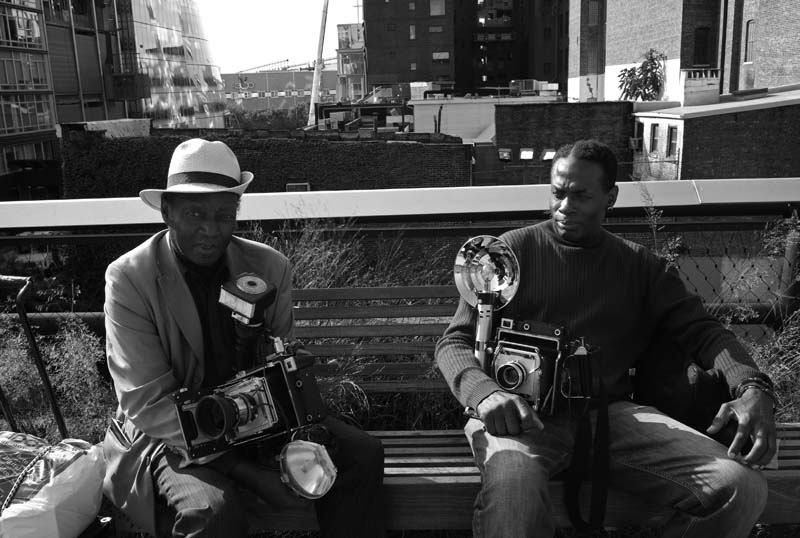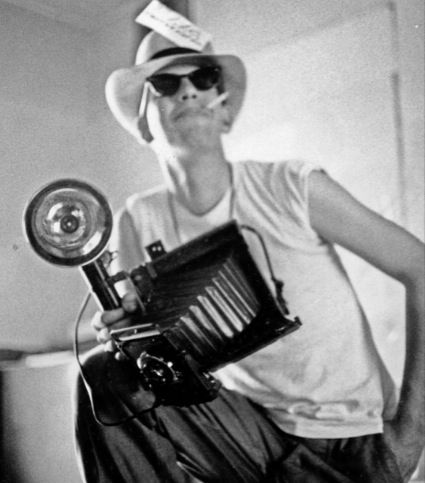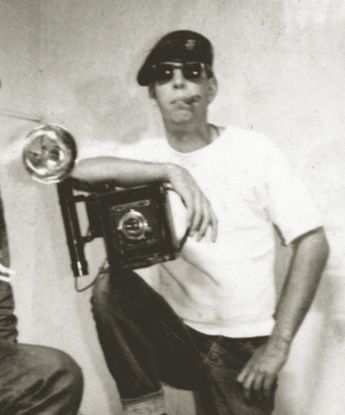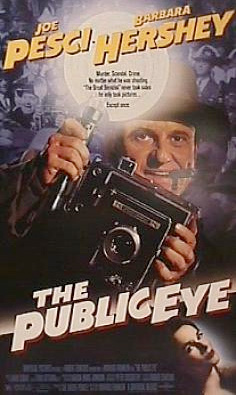 I ran across the old camera ad above entirely by chance the other night while browsing through a 1945 issue of LIFE magazine on Google books. Of course old Arthur Fellig is long gone now—he died at the end of 1968—but Joe Pesci played him in the movie "Public Eye," which is as close to immortality as most photographers are likely to get.
I ran across the old camera ad above entirely by chance the other night while browsing through a 1945 issue of LIFE magazine on Google books. Of course old Arthur Fellig is long gone now—he died at the end of 1968—but Joe Pesci played him in the movie "Public Eye," which is as close to immortality as most photographers are likely to get.
The cameras linger still. There were so many Speed Graphics and Crown Graphics made that they're still common on Ebay. (Like this one—but note that this is not an endorsement.) Many of them work fine, too, or can be made to work fine. You can mount a modern lens if you want to, but the old 127mm and 135mm Ektars and Optars and so forth are pretty good. With just a little mechanical aptitude you can figure out for yourself how to reverse the front standard to get a little front tilt. Its primary limitation as a tripod camera—a field view camera substitute—is that the back is fixed and can't be rotated to vertical. The old press guys just rotated the camera, same way you do your SLR. Like the cat at the bottom of the picture below. Or they took a wider view and cropped to what they wanted. The negative was so big you can do that.
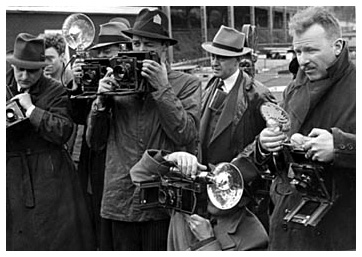 The ones with the top-mounted rangefinders are the latest, but why not an earlier one? There's no shame in toting a tatty Graflex—maybe the opposite. Cheryl Jacobs Nicolai, who's been much in evidence on TOP the past few days, owns and uses one that dates from the 1930s. As long as the bellows are sound—and the shutter works—you can usually get them taking pictures again.
The ones with the top-mounted rangefinders are the latest, but why not an earlier one? There's no shame in toting a tatty Graflex—maybe the opposite. Cheryl Jacobs Nicolai, who's been much in evidence on TOP the past few days, owns and uses one that dates from the 1930s. As long as the bellows are sound—and the shutter works—you can usually get them taking pictures again.
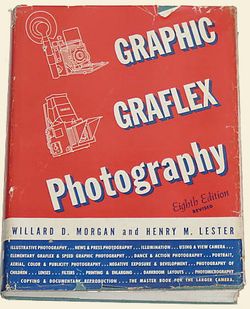 The ad mentions two books, and you can even still get those. A little digging turned up a copy of Graphic Graflex Photography on Ebay. It was penned by the indefatigable Willard Morgan. And The Naked City is still in print—sort of. The available paperback is un-recommendable because of its poor quality reproduction. That's not poor quality in a good way, either. I'm not going to link to it. Hold out for a hardcover from the '40s, which shouldn't be too expensive if you find a later edition at a used bookstore.
The ad mentions two books, and you can even still get those. A little digging turned up a copy of Graphic Graflex Photography on Ebay. It was penned by the indefatigable Willard Morgan. And The Naked City is still in print—sort of. The available paperback is un-recommendable because of its poor quality reproduction. That's not poor quality in a good way, either. I'm not going to link to it. Hold out for a hardcover from the '40s, which shouldn't be too expensive if you find a later edition at a used bookstore.
The Naked City would be a good candidate for reissue, but I'd like to see it as a replica of the first rather than a remake. The hardcover from the era has a certain rough but robust charm. Paging through it, you can easily imagine why the pictures hit the more constrained and upright societal norms of the day like a bomb. It's a period piece as much as a masterpiece of photography.
Mike
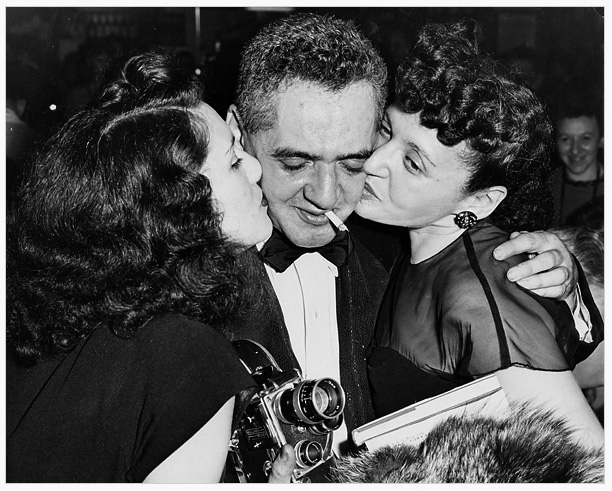
Featured Comment by Dave Karp: "Pick up a Crown and take a trip into a different era. Make photos with a Kodak or Wollensak lens made in N.Y. Look through a groundglass augmented by an exquisite Kodak Ektalite fresnel. Experience a beautifully engineered and extremely well made piece of photographic machinery. Delightful."
Featured Comment by Martin Rich:
Featured Comment by David: "For those of you visiting NYC for the Javitz show or to shop at B&H, the 'gentleman with the hat and the Speed Graphic' [left, in Martin Rich's picture above —Ed.] is Louis Mendes. He and his camera are kind of a local fixture around town. Funny to see him mentioned thrice and photographed twice in the comments."
Featured Comment by Carl Leonardi: "One of the only cameras you could love and hate all at the same time. I really think the camera was made for people with four hands. One to change flash bulbs—one to focus—one to change the film holder—and one to hold the camera. Oops, and one to cock the shutter. Great camera when I was in the army—although I reached for the Leica most of the time."
Featured Comment by Robin Dreyer: "I've owned—and heavily used—several of these. There's good website devoted to Grapic cameras: graflex.org, where you will find geneologies, suggestions, instructions, loving essays, and a forum.
"A few notes for prospective buyers. The 'Speed' Graphic has a big clunky focal plane shutter that—if it works right—goes up to 1/1000, hence the name (that was pretty fast back in the day). This is no advantage on a tripod, so a better choice is the 'Crown' which is the same camera without the extra bulk and weight of the shutter—you just use the lens shutter.
"The top of the line if you aren't using it handheld is the 'Super' also called the 'Super Speed' even though it doesn't have the focal plane shutter. This model is just like the Crown except it has a rotating back—nice for people using their Graphic as a view camera.
"These cameras were entirely designed for handheld use—hence the viewfinder, sports finder, rangefinder, shutter button, etc. But if you are putting it on a tripod and focusing through the glass, you don't have to care whether any of that stuff works (even thought it's all ingenious and cool).
"And the best thing of all is that they made hundreds of thousands of these and they've never really acquired collectible status, so they don't cost much and there are lots of parts around A Crown Graphic with an Ektar or Optimus lens is still the cheapest way to get into large format—this setup will easily make negatives as sharp and richly detailed as what you get from a Hasselblad. And there's no reason you can't put a nice modern view camera lens on them, either.
"Finally, these are beautifully made industrial machines intended for camera-abusing professionals. They do have limitations in the camera movements department, but they are a joy to use."
Featured Comment by K. Praslowicz: "I love that Weegee has an ad for Graflex, and a pretty much identical one for Burke & James."
Featured Comment by Greg Smith: "Hah! Used one in the army as battalion photographer. Wonderful old thing. Had a Polaroid back for it, a closet full of film, and had a lot of fun with that, too.
"But my favorite memory was finding a box full of flashbulbs the size of 100W incandescent bulbs that were absolutely packed with fine magnesium (a guess) wire gauze. Man, they were bright when you set one off. Chain of command photos of new lieutenants, basically a polite mug shot, I would be about six feet away, ƒ/200 gazillion, the Sergeant-Major snickering as he turned his head away from the explosion of light that he knew was coming, and the new lieutenant smiling naively, deer-like, just before he lost his eyebrows to ash and left a Hiroshima-like shadow on the wall behind him...I think they were bulbs for night-time scenes, like football games, designed to light one half of the field. Tremendous fun. You didn't so much trigger that flash as detonate it...."
Featured Comment by Cheryl Jacobs Nicolai: "I have and regularly use a '38 Speed Graphic and a 1950s Press King 4x5, as well as a host of old folders of various sorts. Each of them has a distinct personality and a quirk or two, which make them very rewarding to shoot. My friends are constantly bringing me old camera gear they've come across, to see if I can do anything with it. I've gotten a few strange looks on commercial shoots busting out the old gear, but the results speak for themselves."
